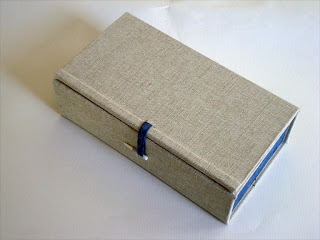And so happily, I learned to make books.
This first example, above, was my all-time favorite; a concertina form that holds separate signatures within a small half-accordion frame. This cover is made from a soft green Lotka paper (traditionally made from a plant in Nepal), with each signature held by waxed binding thread of a different color. This will be the format for a portfolio of architecture work.
This narrow, horizontal book (above) is a well-known Japanese Stab binding, filled with hand-made denim and abaca paper, with tea leaf & abaca `tipin' (meaning an additional page that is different than the body of the book and often is the first sheet you encounter when you open the book).
Much more of a traditional `book', the above binding is a kind of Perfect-Bound book, also known as flex binding, where the pages are glued in a text-block but still flexible and separate from the Davey Board spine. The fabric is silk, and the interior of the boards are lined with suminagashi paper (Japanese traditional marbling technique using ink (sumi) and water).
These two books are not shining finished examples of binding techniques, but they were learning experiences and represent two types that I'd like to explore further because of their durability. The top image is a Sewn-to-Tape binding, using a cloth that belonged to my grandmother as the cover. Cloth must first be prepared by adhering it to paper and drying, and if you buy book cloth this will have already been done for you. The tape itself is made of fabric, and can be purchased in various widths. The bottom is Sewn-to-Chord- much trickier in my opinion and I much prefer the tape.
Along with accordion books, we tried several different folded structures that have their roots in origami. This sweet little book includes a ribbon that would allow the book to be tied closed or hung open. I later played with paste papers I had made to create two variations on this theme, below:
Paste papers are just what they sound like-- plain paper that is painted with a paste-like paint. Using tools & implements that have texture or teeth, you can manipulate multiple colors and the paper begins to have a sense of depth as a result of the translucency created by the paint. Later, this paper can be trimmed creating beautiful snapshots of color and texture.
The Dos a Dos is a simple folded structure that we learned early on in class while mastering simple binding stitches. It also lends itself well to color and content play:
The Altered Book is something we spent very little time on, but held the most fascination for me. Some altered book artists are just, well, badass. Their alterations are pure labors of love. I hope to post some links to these amazing artists in a future blog, but for now my first humble effort- a used book called "The Fear Makers"-- which involved a fictional story set in Germany during WWII. Not knowing the story line (and with no time to read it), I responded to the cover, title, and my own take on the events of the time. This was the altered state:
A few final projects and thoughts:
The box was a time and measurement intensive endeavor, but with satisfying results. This box is made with a linen book cloth, bone clasp (from already deceased animal bones, for those concerned about animal cruelty), and Lotka paper latch and lining:
Along with bookbinding, we made paper (as mentioned) and honed our typesetting skills-- with a trio of linoleum cut, wood type, and lead type all poured into one project, we learned to (at the very least) appreciate the pain and suffering of our typesetting forbears and (at the most) appreciate the wonderful possibilities of super-cool antique typesets. Below is the origin of my experiments-- a wedding guest book for dear friends:
And speaking of possibilities; paper Paper PAPER! Each project seemed to respond so differently to each choice of paper-- texture, color, and weight. Check out the same linoleum, wood, and lead type design on various papers versus book cloth:









































